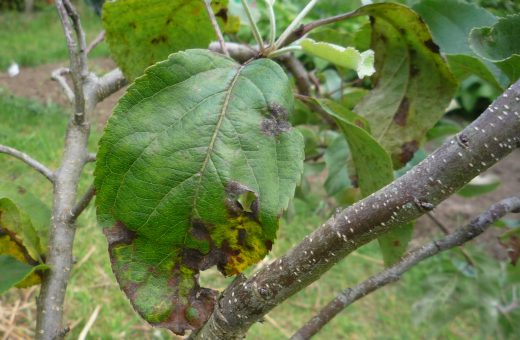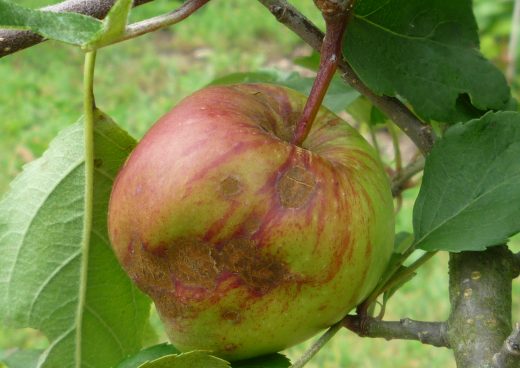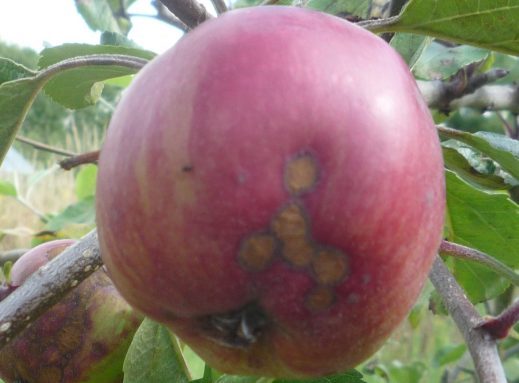IDENTIFY AND TREAT APPLE TREE SCAB
Scab is a fungal disease which is spread mainly by spores in the air but also in water droplets. It affects apple and pear trees, hawthorn and mountain ash. The technical name for this fungal infection is Venturia inaequalis. Note the scab also affects pyracantha but it is a slightly different strain and apple trees with scab do not infect pyracantha or the other way around.
This disease is a major problem for commercial growers of tree fruit as well as the amateur gardener. One simple solution which reduces the problem considerably is to choose resistant varieties and avoid those varieties which are susceptible to the disease.
The second key preventative measure is keep the nearby soil and /or grass clear of all fallen leaves and debris from the tree.
IDENTIFYING SCAB
The first signs of scab appear on the leaves of affected plants in spring. Small yellow patches appear on the leaves. After a few weeks the leaves will develop larger brown / dark olive-green marks on them and the leaves will begin to turn yellow and start to prematurely fall off in July and and August.

![]()
A leaf infected with Scab
The fruits have greyish, slightly raised or sunken areas on the surface. This affected area will not grow with rest of the apple causing it to split eventually, providing an ideal site for other infections to enter.

![]()
An apple fruit affected by scab
LIFECYCLE OF SCAB
SUMMER
The initial infection normally occurs in summer but the effects are not particularly noticeable in the first year.
AUTUMN / WINTER
In first autumn and winter the infected leaves fall to the ground and they overwinter.
SPRING
In Spring, normally around the time that buds appear on the plants, spores are released form the fallen leaves and they spread to new leaves both on the wind and via water splashing. Secondary spores are release in late spring which causes further infection. The higher the humidity and temperature the quicker the spores are released and the more damage they can cause.
AUTUMN / WINTER
The damage becomes apparent in mid summer to winter on leaves and fruit. The cycle repeats itself with more vigour if not treated.
DAMAGE CAUSED BY SCAB
Scab will cause premature leaf drop which not only affects the looks of affected plants but also weakens them and affects their ability to produce fruit. In the short and medium term it is unlikely to kill the plant / tree but it can do so if the disease reappears year after year.
The primary damage is caused to leaves, reducing their ability to convert sunlight to energy, opening up the plant to other infections as well. Severe cases may result in almost all the leaves dropping off causing the plant to die.
The fruits are also affected although scab, of itself, does not make the fruit inedible. Sometimes the scarred area on the fruits split opening it up to other infections which can totally ruin the fruit.

![]()
Another apple fruit affected by scab
Sometimes the damage caused to apple fruit by bitter pit is mistaken for scab. However bitter pit scars remain very small whereas the scars from scab increase in size as the fruit grows. If you cut into a fruit affected by bitter pit the damage can often go to the centre of the apple.
PREVENTING AND TREATING APPLE SCAB
The single most effective preventative measure for scab is to plant resistant varieties. This is especially important with apples, crab apples and pears. If you have been affected by scab before then research the varieties you buy in the future to include only those which show good resistance. The list below is for common apple varieties we know which have good resistance to scab:
COMMON SCAB RESISTANT APPLE TREES UK
Rajka
Red Windsor
Reverend W Wilks
The second best way to lessen the effects of scab is to clean up and burn all affected leaves and debris around the the tree / plant. If you religiously pick up all fallen leaves and fruit throughout the year, scab can be significantly reduced – quite possible if you only have a couple of trees but virtually impossible if you have lots of them.
A complication occurs with clearing up leaves however. The spores of scab can travel several hundred metres on the air so you can keep a scrupulously clean garden but still have your trees infected by neighbouring trees.
Couple that with the fact that scab affects pyracantha and hawthorn, both very common in urban, suburban and even country side areas, and you may be faced with a stark choice. Replant with one of the resistant varieties or accept that fruit production will be significantly reduced and those fruits which are produced may well be scarred.
There are no longer any chemical sprays available to the UK gardener for treating scab on apple trees where the fruit will be eaten. Copper based fungicides are also no longer sold in the UK.
COMMENTS / QUESTIONS LEFT BY OUR READERS
ANSWER: Pulling off the leaves doesn’t have any direct benefit. However, leaves will start to fall naturally from the tree very soon and to help avoid scab next year it’s best to sweep them all up and burn them. It may or may not be more convenient to pick the leaves off the tree now, it’s really a matter of convenience.
ANSWER: The most effective organic method as far as apple scab is concerned is to sweep up and burn all fallen leaves. Choosing scab resistant varieties in the first place will greatly help, see the list above in the main article.
WHY NOT LEAVE YOUR QUESTION / COMMENTS ABOUT THIS PAGE?
ENTER THEM BELOW. EMAIL ADDRESS IS OPTIONAL.
YOUR COMMENTS WILL BE ADDED ABOVE WITHIN A FEW HOURS.
[contact-form-7 id=”1882″ title=”Contact form 1″]